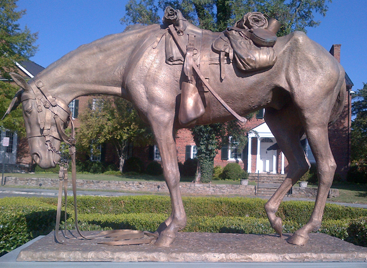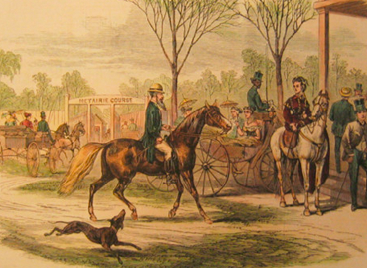Civil War Horses

According to some historical accounts, easily half of Lexington’s wartime-born foals fell into war service by conscription or theft. That they survived to carry forth his bloodline is unlikely. The Civil War required much of the horse. By conservative estimates, as many as 1,000,000 horses were killed in battle or died from exhaustion, starvation and hard usage. One historian focusing on equine mortality during the Civil War raises the number to between 1,350,000 and 1,500,000. The average life expectancy of a Civil War horse was six months; four months for a cavalry horse. During the first eight months of 1864, the Army of the Potomac’s cavalry was remounted twice equating to forty thousand horses.
In his memoirs, Hardtack and Coffee, Union Private John D. Billings wrote, “Those who have not looked into the matter have the idea that actual combat was the chief source of the destruction of horseflesh. But, as a matter of fact, that source is probably not to be credited with one-tenth of the full losses of the army in this respect…. hard pulling, exposure, and hunger conspired to use them up very rapidly.”
The Civil War was heaped on the backs and legs of horses and mules in the form of twenty-two ton guns and sixty-ton caissons, thick canvassed Sibley teepee-shaped tents and other tents shaped like boxes complete with fourteen-foot iron poles, crates, tables and chairs, wool blankets by the hundreds of pounds, rubber matting, food supplies, hardtack and government-procured high grade coffee, beef rations—if available—corn, lots and lots of sugar, salt, pepper, flour—if available—and whiskey for drinking, along with all the paraphernalia to convert the food supplies into half-palatable meals. Grain and hay for horses—if available. Plus, surveying and mapping equipment, banjos and violins to sing about battle triumphs, losses, and the girl back home, writing utensils, stamps, paper, ink, telegraph wires and equipage, soaps, medicinal whiskey, and other medical supplies. All the maimed and dying soldiers had to be carried too.
The war was so treacherous to horses that the documentation of the average regiment’s comings and goings reads like Destruction’s chart of victories. The “Official Records of the War of the Rebellion” for May through August 1964, in the southwest regions, records:
May 9-13, 1864:
During a march of the Michigan Cavalry, horses were so used up the march had to stop. Horses had no forage during the three-day march.
June 5, 1864:
39th Kentucky Volunteers: thirty-one unserviceable horses; many have sore backs from carrying the heavy packs.
June 12, 1864:
Headquarters US Forces: horses starved and weakened and unable to pull wagons and artillery from mud.
June 14, 1864:
113th Illinois Infantry: two horses killed while carrying a cannon gun. Other horses were saved.
June 15, 1864:
4th Iowa Cavalry: headwaters of the Hatchie River so completely choked with abandoned guns, caissons and wagons, ambulances, and dead animals…. forage scarce; the animals not supplied with more than half rations of grain and the last two days there was no grain, though the labor of the horses was exceedingly severe. Continuous rain added to this evil.
June 24, 1864:
Horses are starved and exhausted and having difficulty dragging the artillery and wagons. It is impossible to find forage. The roads are in bad condition.
June 25, 1864:
7th Ohio Cavalry: horses drowned while crossing a river. Other horses fatigued having no food in twenty-four hours.
July 8, 1864:
37th Kentucky Infantry: one hundred and sixty “good” horses selected to march 460 miles from Cynthiana to the Cumberland River and back to Lexington, Kentucky. Most have already traveled nearly 1,000 miles. The horses were broken down; only having received eight ears of corn, subsisting on bushes, weeds and a little white clover.
July 23, 1864:
4th Iowa Cavalry: march of 350 miles over broken and barren country affording little forage and water. Animals supplied about ¾ ration of forage. 19 horses killed, 32 wounded and 40 abandoned.
July 24, 1864:
3rd Iowa Cavalry: due to lack of forage, for three days the horses were scarcely fed. These facts combined with intense heat, dustiness of the roads, and severe labor accounts for the great deterioration of the horses.
August 5, 1864:
1st Ohio Heavy Artillery: many horses fell by the roadside due to fatigue and breaking down. We were compelled to leave them on the mountains where they fell.
August 26, 1864:
3rd Iowa Cavalry: the horses from the battery suffered most as the toil they have had to undergo has been greater than animals can stand.
When J.H. Kidd wrote his memoirs about riding with George Armstrong Custer’s cavalry, his chief complaint was the mud. Seemingly, every battle march through every state encountered horrid, glue-like, gummy mud. But, he wrote, Virginia’s was the worst. It was the kind of mud that grabbed a soldier and pulled him down up to his knees. Pulling his leg out was akin to a miniature battle with the suction-vise of dirt. Finding his shoe was another. It was quicksand-horse-and-gun-eating mud, an entrapment as if Mother Nature had conspired with the Rebels. Just like the sub-terra shells the Confederate soldiers reportedly planted underground at Vicksburg, and under the Orange & Alexandria Railroad, and the ones planted in the fields surrounding Savannah–shells that exploded a man and horse into the heavens when they applied their weight. The mud, it seemed, was just another Southern concoction set up to destroy the Union.
Everything would have been a lot better if the armies could have stayed put. But armies had to move, and moving an army was a massive undertaking. Traveling on a good road was bad enough considering the weather, multiple travelers, and vehicles of all grades and weight that beat roads down into barely passable thoroughfares. When Virginia rain saturated the roads, traveling became about as bad as fatigue duty. Horses and mules dragging multiple ton wagons and guns became so burdened in the mud that teams of soldiers had to toss aside their muskets to pull and push on the rumps of the animals and the wagon’s wheels just to budge them. Sometimes they moved only inches at a time. If at all.
Writing of General Ambrose Burnside’s infamous mud march, General Alpheus Williams described the impassable roads: “Many of our wagons stuck fast inextricably and many mules were drowned in the middle of the road, fairly swallowed up in the mud. It was, in places, really difficult to force a horse through the tenacious stuff.” The mud was so deep during that march that sixteen horses couldn’t pull one gun. Separately, twenty-eight horses stalled with a cannon. The 33rd Massachusetts Infantry alone lost sixty horses and three hundred mules to Burnside’s mud march. Large draft horses pulling wagon trains stood paralyzed in mud up to their heads. Some infantries shot horses who fatigued in the mud. Others unloaded wagons to ease the weight, hoping the horses could pull out. Some did, but most horses died. All of it happened over a four-mile span in two days.
Beyond contending with mud, marching a wagon team often resulted in dead horses both along the way, and at the end of the march. The reasons were multiple. Not only were the roads exceedingly bad, but the animals were underfed because of lack of food or forage in the area. What started out as plump, well-nourished and conditioned horses turned into rib protruding animals who, lacking energy, held their necks low. Fatigued animals either gave out, suffered from disease, or became lame, only to be shot or abandoned. The sight was too familiar. Private Billings wrote of soldiers who saw “carcasses of horses which dotted the line of march, animals which had fallen out from exhaustion and disease, and left by the roadside for buzzards and crows. These they can recall by the hundreds.” General Grant wrote that on his route from Bridgeport to Chattanooga, the roads were strewn with ten thousand mules and horses lying beside broken wagons and caissons. Charles A. Dana, traveling with Grant, corroborated the report, adding that the ten thousand animals starved in a two-month span.
The detail of burying horses was a job no man wanted, not only because it reminded him of burying his dead brethren, but because of the sheer magnitude of the task. A simple skirmish could result in twenty dead horses. A battle like Shiloh saw upwards of five hundred on just the Union side. Several mass graves had to be dug, and after the horses were rolled, pushed, or pulled into the pit, the earth had to be replanted on top. Fatigue duty of this nature was full of objections, excuses, feigned illnesses, allegations of favoritism for those not chosen, and outright bribing to get out of it.
In larger battles, where horse deaths numbered in the hundreds, digging graves was too futile a task to even bother. Horse bodies were drug, pushed, rolled, or dismembered and heaped in large, sprawling piles. Then they were set alight. There was usually more than one grouping and often entire sections of the battlefield were set ablaze with burning animals.
Aside from the fatiguing nature of the duty, the men had to contend with the sight, the smells, and all it represented. Bloated horses turned upright with legs dangling in mid-air, or horses with severed limbs, or those bodies mangled into indistinguishable forms, or a hoofed leg peeking out from under an overturned Howitzer gun, or the battered head with expressionless and disarranged eyes, or those horses that retained their beauty even in the horrors of massacre. These mangled and torn bodies, like the dead men on the battlefield, represented an awakening slap of mortality. A draining of the battlefield euphoria. A stark reminder that even beautiful things are touched by death. To Kidd, burial of the dead, and all their broken parts—just the sight of the dead— “the bloated carcasses of once proud and sleek cavalry chargers; the mounds showing where the earth had been hastily shoveled over the forms of late companions-in-arms—everything was suggestive of the desolation, nothing of the glory, of war.”


